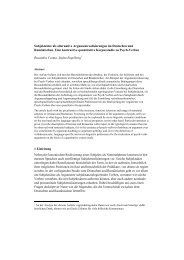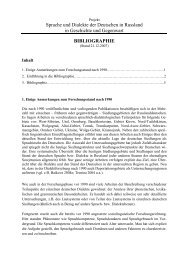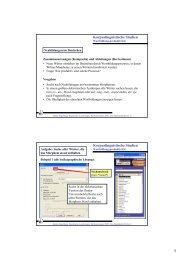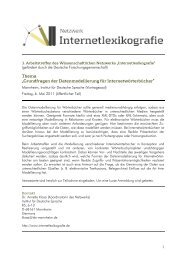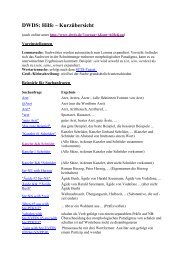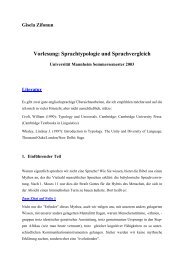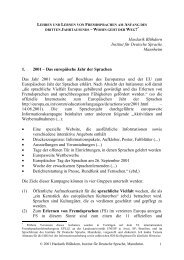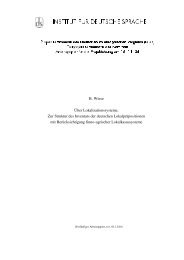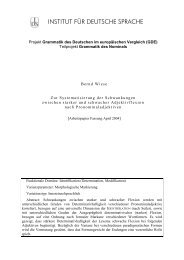Subordination and coordination in syntax, semantics and discourse ...
Subordination and coordination in syntax, semantics and discourse ...
Subordination and coordination in syntax, semantics and discourse ...
Create successful ePaper yourself
Turn your PDF publications into a flip-book with our unique Google optimized e-Paper software.
<strong>Subord<strong>in</strong>ation</strong> <strong>and</strong> <strong>coord<strong>in</strong>ation</strong>An unresolved theoretical problem <strong>in</strong> RST has to do with the concept of a<strong>discourse</strong> relation. Syntactic subord<strong>in</strong>ation <strong>and</strong> <strong>coord<strong>in</strong>ation</strong> are def<strong>in</strong>ed asrelations between syntactically categorized units (such as phrases, clauses orsentences) with certa<strong>in</strong> syntactic functions (such as head, complement oradjunct). Symmetrical <strong>and</strong> asymmetric semantic connections are def<strong>in</strong>ed asrelations between semantically categorized entities (such as spatial objects,events or propositions) bear<strong>in</strong>g semantic or thematic roles (such as agent, theme,cause, goal etc.).Similarly, hierarchical <strong>and</strong> non-hierarchical <strong>discourse</strong> relations should bedef<strong>in</strong>ed as relations between rhetorically categorized units (such as utterances orspeech acts) with certa<strong>in</strong> rhetorical functions (such as topic <strong>and</strong> focus, or<strong>in</strong>tended communicative effects). But that is not how <strong>discourse</strong> relations aredef<strong>in</strong>ed <strong>in</strong> RST. The basic units of analysis <strong>in</strong> RST are clauses, sentences orphrases, i.e. syntactic units. The relations between these units are divided <strong>in</strong>to“subject matter” <strong>and</strong> “presentational” ones (Mann & Thompson 1988: 256f; alsoTaboada & Mann 2006: 435f). The former are clearly semantic relations such ascause, condition, result etc.; the latter are pragmatic relations between speechacts such as evidence, motivation, justify etc. Only the latter deserve to be called<strong>discourse</strong> relations <strong>in</strong> the strict sense of the term.RST is a hybrid model that <strong>in</strong>corporates syntactic, semantic <strong>and</strong> rhetoricalconcepts <strong>and</strong> categorizations (see Stede <strong>in</strong> this volume). RST tree diagramsconta<strong>in</strong> <strong>in</strong>formation of different doma<strong>in</strong>s. This makes them suggestive <strong>and</strong> at thesame time non-conclusive <strong>in</strong> relation to a possible parallelism between sentence<strong>and</strong> <strong>discourse</strong> structure. They are suggestive to the extent that their basic unitsare syntactic <strong>in</strong>stead of rhetorical categories, <strong>and</strong> they are non-conclusive to theextent that these units are associated with partly semantic <strong>and</strong> partly rhetoricalfunctions.4.2.2 The L<strong>in</strong>guistic Discourse ModelA more homogeneous account of <strong>discourse</strong> structure is offered by Polanyi’s(1988) L<strong>in</strong>guistic Discourse Model (LDM). In LDM, <strong>discourse</strong> is segmented<strong>in</strong>to <strong>discourse</strong> constituent units of different levels of complexity. The units at theelementary level are clauses <strong>and</strong> so-called <strong>discourse</strong> operators (assigners,connectives <strong>and</strong> <strong>discourse</strong> markers) (ibid.: 605f). Constituents at the levels ofhigher complexity are genu<strong>in</strong>e <strong>discourse</strong> units such as <strong>in</strong>teractions, speechevents, stories, plans, question-answer sequences, lists etc. (ibid.: 603).Representations of the elementary level of <strong>discourse</strong> structure <strong>in</strong> LDM are© 2007 Hardarik Blühdorn, Institut für Deutsche Sprache, Mannheim. 23



![Ãœbersetzungen-19[1]. - Institut für Deutsche Sprache](https://img.yumpu.com/51701205/1/184x260/aoebersetzungen-191-institut-fur-deutsche-sprache.jpg?quality=85)


